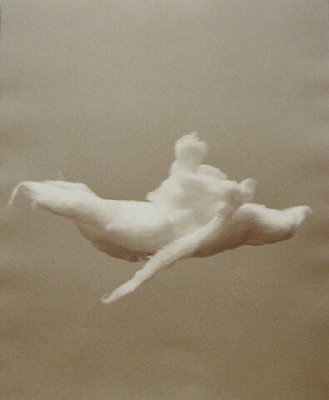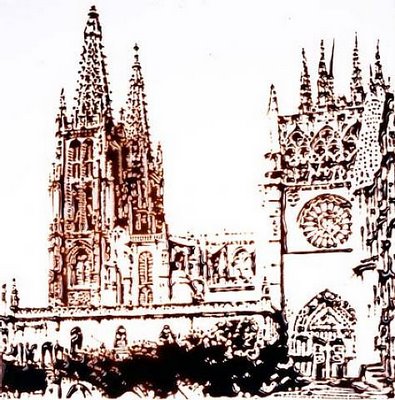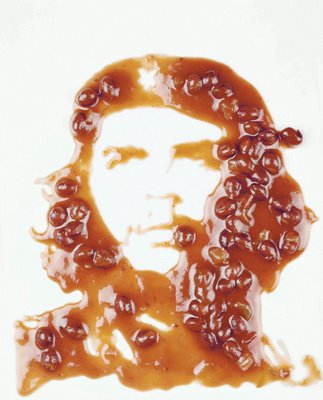
Kitty Cloud, 1993

The Rower, 1993

Catedral de Burgos (Pictures of Chocolate) 2003
“I want to make the worst possible illusion that will still fool the eye of the average person,” Muniz says. “Something so rudimentary and simple that the viewer will think, ‘I don’t believe what I am seeing, I can’t be seeing this, my mind is too sophisticated to fall for something as silly as this. Illusions as bad as mine make people aware of the fallacies of visual information and the pleasure to be derived from such fallacies. These illusions are made to reveal the architecture of our concept of truth.”

Karl Marx (Pictures of Caviar, 2004)

Frankenstein (Pictures of Caviar) 2004

Marlene Dietrich (Pictures of Diamonds) 1994
"I'm experimenting with these things as a student of media. We're at the point where in order to perceive a phenomenon, you have to change it, like particle collisions in physics. What else can you do without relying on the actual reality of things? Art is just as important as science because it completes it; one is about phenomenon while the other is about mind. One thing is totally dependent on the other; that's why I am very drawn to cognitive science. How many artists spend their entire lives making visual objects and never pick up a book to study how the eye works? They never studied the physics of light to see how light behaves. They never bought a prism, and held it against the sun, or any of these really simple things. I'm a visual artist, not a conceptualist. I make things that deal primarily with the eyes. In that regard, I'm totally old-fashioned.”

Aftermath (Sócrates) 1998

Mars, God of War, after Diego Velázquez (Pictures of Junk) 2005

Che Guevara (Pictures of Food) 1998
“Vision is a form of intelligence, even more so than hearing. Our human eyes are not nearly as good as birds' eyes or many other animals'. Instead, we have a huge visual cortex devoted just to analyzing visual stimuli. That is our true eye. I have a theory that the intellect has evolved from our inability to see everything in focus, the eye has to move to see things and by doing so it introduces the concept of narrative and the attention that is necessary for any complex idea to form.”

I wait, after Julia Margaret Cameron (Pictures of Junk) 2004
Questions:
- Why do you think Muniz presents his work as photographs of his re-creations of previous artworks, rather than, say, gluing all the pieces down and presenting the "original" work? For that matter, what level of this process is the "original" work?
- Muniz states- "Illusions as bad as mine make people aware of the fallacies of visual information and the pleasure to be derived from such fallacies. These illusions are made to reveal the architecture of our concept of truth." How do you think this idea is represented in his work?
- How would you compare and contrast Muniz' work with Thomas Demand, from Ch. 2?

5 comments:
All of these photographs are very interesting to look at not only because of their subject matter, but more importantly, the various materials that made up them. These pictures create illusions and they work well to fool viewers’ eyes. However, when viewers realize the reality, the material used to create such art work in this case, they will be "aware of the fallacies of visual information" and feel "the pleasure to be derived from such fallacies." This is mainly because Muniz uses recognizable material that we known from everyday life in his works, such as caviar, chocolate and junk. He does it so well that when we first look over the entire art work, we can easily tell the subject matter. Later when we close exam these pictures, smaller details will strike our eyes, and we start to recognize these particles. Viewers become interested in such works not only because the presence of familiar materials, but also their discovery of the truth behind the art work – the material that made up the work. Muniz helps viewers to reveal their concept of truth through visual means.
When I first look at these pictures at a glance, I thought they were just ordinary painting, later when looking at them closely, I realize that these materials in the pictures are actually solid or liquid objects and were put together intentionally to form a bigger recognizable image.
When i first saw these photos without reading any of the text, i just thought to myself, 'that is neat, recreations of other works'. Then looking even closer at the photos, I became even more suprised, they were made out of very simple items. After reading the post and all the quotes of Muniz, it started invoking all sorts of thoughts about what he really was trying to achieve. Illusions to fool the eye, phenomenon and the mind, and intellect has evolved from our inability to see everything in focus. A very intruiging approach to art yet all presented as photographs. I believe rather than keeping the originals and presenting the works as photographs, it helps achieve the effect of fooling the eye.
I absolutly love the idea behide these photographs. Who would have thought that misc. objects could be made into faces. The pictures are so interesting to look at and to think about. I think to myself, how did this person do this. The photos are more than just taking pictures they are truly about all aspects of art.
~Brandi Ashlock
When I saw this artist's work, I realized that I had seen it before. We discussed this artist in John Pomara's class. It is interesting to note that the images are created with non-archival products. The original works are not designed to last for a long time. This was not important to the artist. The images were captured in photographs making them last. The subject matter is relatable to the viewer as well as the medium used to create them. This truly is an amazing artist.
Why do you think Muniz presents his work as photographs of his re-creations of previous artworks, rather than, say, gluing all the pieces down and presenting the "original" work? For that matter, what level of this process is the "original" work?
I think, in essence, the photo is the real art. Muniz does create objects, but he choses to present them as photographs; probably because this method of delivery gives him superior control over exactly what the observer sees. He could painstakingly shape a figure out of whatever material, but if it wasn't viewed at the proper angle under the perfect conditions, it would not be the same thing.
I'd just like to point out that the pictures of the cloud figures are amazing. The rest of the work is something any ordinary person could accomplish.
Post a Comment